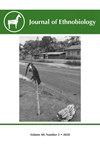对比秘鲁亚马逊地区的土著乌拉里纳和梅斯蒂索农场:植物多样性和耕作方法
IF 1.3
3区 社会学
Q1 ANTHROPOLOGY
引用次数: 1
摘要
摘要偏远的亚马逊社区往往在很大程度上是自给自足的,部分原因是他们的农业技能和对当地景观的深刻生态知识。掌握当地植物无疑在日常生活中起着至关重要的作用,然而亚马逊地区的社区在利用植物的多样性和如何管理农业土地上的植物方面差异很大。社区之间生态知识和实践差异的主要驱动因素尚不清楚。我们比较了秘鲁亚马逊地区土著乌拉里纳社区和梅斯蒂索社区的农业实践和利用植物的多样性。通过实地调查和农民访谈,我们评估了在家庭花园(N = 17)和chacras(作物田;N = 47),以及查克拉斯和休耕地的多重农业特征(N = 32)。来自梅斯蒂索社区的家庭耕种的土地面积更大,而两个社区都利用了相对较短的休耕时间(< 6年)。在这两个社区,农民利用60个植物科共207种植物来获取各种资源,包括食品、香料、医药、燃料、工艺、建筑、狩猎/捕鱼和精神/文化用途。Urarina群落利用植物的物种多样性显著较高,这可能反映了它们在该地区的历史根源较长,对市场经济的依赖程度较低,对农林产品的依赖程度较高,与土地的生物栽培关系较高。亲缘大小与群落多样性呈负相关,而家庭财富的增加导致乌拉里纳人群落物种多样性增加,而混血儿群落物种多样性减少。这些结果表明,混血儿和土著社区,特别是后者,在秘鲁亚马逊地区传统生态知识和农业生物多样性的保护中发挥着重要作用;然而,日益增长的市场一体化可能危及支撑这种就地保护的生物文化关系。本文章由计算机程序翻译,如有差异,请以英文原文为准。
Contrasting Indigenous Urarina and Mestizo Farms in the Peruvian Amazon: Plant Diversity and Farming Practices
Abstract. Remote Amazonian communities are often largely self-sufficient, made possible in part by their agricultural skills and deep ecological knowledge of their landscapes. Mastery of their local flora undoubtedly plays a vital role in daily life, yet communities in the Amazon can vary widely in both the diversity of plants that they utilize and in how they manage plants in their agricultural landholdings. The dominant drivers of these differences in ecological knowledge and practices between communities are not clearly understood. We compare the agricultural practices and diversity of utilized plants in an Indigenous Urarina community and a Mestizo community in the Peruvian Amazon. Through field surveys and farmer interviews, we assessed the diversity of utilized plants found in the homegardens (N = 17) and chacras (cropped fields; N = 47), as well as multiple agricultural characteristics of the chacras and fallow fields (N = 32). Households from the Mestizo community cultivated a larger land area, while both communities utilized relatively short fallow times of < 6 years. Across both communities, farmers make use of a total of 207 plant species belonging to 60 plant families for various resources, including food, spices, medicine, fuel, craft, construction, hunting/fishing, and spiritual/cultural uses. Species diversity of utilized plants was significantly higher in the Urarina community, likely reflecting their longer historical roots in the region, lower reliance on a market economy, greater reliance on farm and forest products, and higher degree of biocultural relationship to the land. Kin size was negatively correlated with homegarden diversity, while increasing household wealth led to more species diversity in Urarina landholdings, but less diversity in Mestizo landholdings. These results suggest that both Mestizo and Indigenous communities, and especially the latter, play an important role in the conservation of traditional ecological knowledge and agrobiodiversity in the Peruvian Amazon; however, increasing market integration may jeopardize the biocultural relationships that undergird this in situ conservation.
求助全文
通过发布文献求助,成功后即可免费获取论文全文。
去求助
来源期刊

Journal of Ethnobiology
Social Sciences-Anthropology
CiteScore
4.80
自引率
3.40%
发文量
21
审稿时长
>12 weeks
期刊介绍:
JoE’s readership is as wide and diverse as ethnobiology itself, with readers spanning from both the natural and social sciences. Not surprisingly, a glance at the papers published in the Journal reveals the depth and breadth of topics, extending from studies in archaeology and the origins of agriculture, to folk classification systems, to food composition, plants, birds, mammals, fungi and everything in between.
Research areas published in JoE include but are not limited to neo- and paleo-ethnobiology, zooarchaeology, ethnobotany, ethnozoology, ethnopharmacology, ethnoecology, linguistic ethnobiology, human paleoecology, and many other related fields of study within anthropology and biology, such as taxonomy, conservation biology, ethnography, political ecology, and cognitive and cultural anthropology.
JoE does not limit itself to a single perspective, approach or discipline, but seeks to represent the full spectrum and wide diversity of the field of ethnobiology, including cognitive, symbolic, linguistic, ecological, and economic aspects of human interactions with our living world. Articles that significantly advance ethnobiological theory and/or methodology are particularly welcome, as well as studies bridging across disciplines and knowledge systems. JoE does not publish uncontextualized data such as species lists; appropriate submissions must elaborate on the ethnobiological context of findings.
 求助内容:
求助内容: 应助结果提醒方式:
应助结果提醒方式:


